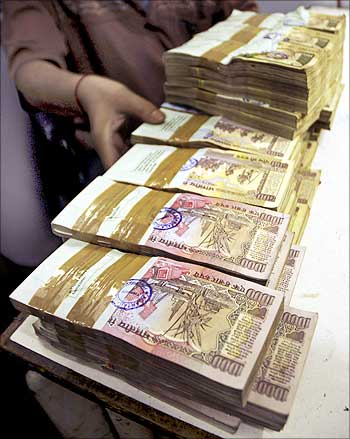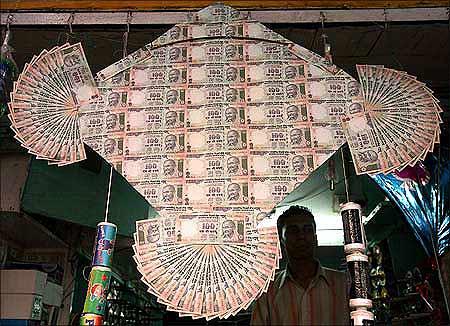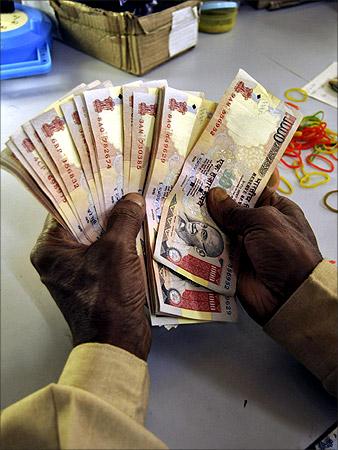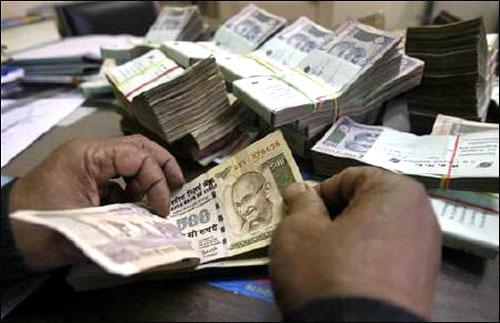Photographs: Reuters. Subir Roy
The markets tanked last Friday - by 2.25 per cent, the biggest decline in 15 months - despite the fourth-quarter (2012-13) GDP figures being in line with analysts' expectations.
"Global cues", as they are called, were there, but what affected investors most was the rupee's fall to an 11-month low against the US dollar.
Since the 1980s, the Indian government has stopped firmly supporting the rupee and allowed it to float whichever way the markets will take it, in an orderly manner. As opposed to that, the sharp devaluation in 1966 became a significant political issue, with the left losing no opportunity to use it as a stick to beat the government.
The last major devaluation or depreciation was in 1991, when in a week, over two phases, the rupee lost 18 per cent of its value against the US dollar. This measure contributed to the success of the first round of reforms introduced since 1991.
...
The rupee's fall still makes waves
Image: Indian rupee noted in the shape of a kite.Photographs: Reuters.
It is well known that when major operators determine that they have tilted too much to one side, are sharply overbought or oversold, they will cover their positions, thereby taking the market down or up - and they will cite macroeconomic or political reasons for it.
So, too much should not be made of declared reasons for market movements. But still, certain arguments, if not reflexes, should simply go out of fashion.
A key one is publicly worrying about the state of the rupee. It should be clear that a sharp change in benchmark exchange rates is a symptom and not a disease. It is like perspiring when the mercury goes up.
The culprit is not the waywardness of the sweat glands; it is the ambient temperature. A significant shift in exchange rates invariably means the system is successfully adjusting itself to a new equilibrium in view of important developments that have already taken place.
...
The rupee's fall still makes waves
Image: A bank employee counts currency notes at a cash counter in Agartala.Photographs: Jayanta Dey/Reuters
This ability to adjust should be seen as a positive sign - that the economy has now laid the groundwork for a successful therapy - and the markets should actually rise, not fall, on the rupee's decline.
Conversely, sharp currency inflows should cause the rupee to first significantly appreciate, making imports cheaper, drawing down excessive reserves and thereafter slowly taking down the exchange rate.
The exchange rate between two floating currencies captures the overall competitiveness between them. But within that the exchange rate, above all, reflects the recent comparative inflation rates.
In March, the year-on-year retail inflation rate in the US was 1.5 per cent and in India 10.4 per cent.
It is, therefore, not surprising that the nominal effective exchange rate - based on a basket of market rates of India's main trading partners - declined by 5.9 per cent during 2012-13 but the real effective exchange rate - which takes into account the difference in inflation - declined by only 2.4 per cent. Over the same period, the rupee depreciated against the US dollar by 7.5 per cent.
Signs of the willingness and ability of foreign exchange markets to be efficient and flexible and take the country's exchange rate up or down in response to macroeconomic developments should be a cause for satisfaction, not otherwise.
...
The rupee's fall still makes waves
Image: An employee counts rupee notes at a cash counter inside a bank in Agartala.Photographs: Jayanta Dey/Reuters.
This can be seen from what happens when a country cannot devalue when it wants to. This was dramatically brought out when the 2007 financial crisis hit Europe.
Iceland was able to substantially recover by 2011 by following a package of measures whose key element was a devaluation of the krona by more than 35 per cent against the euro from January to September 2007.
In contrast, Greece and the earlier European poster boy Ireland are far from having set their systems right - for several reasons, foremost of which is their inability to devalue because they are now part of the euro zone.
...
The rupee's fall still makes waves
Image: Indian rupee notes.Photographs: Mukesh Gupta/Reuters.
The classical historical case of a country being reluctant to devalue when there is an urgent need was that of Britain in 1992, when the pound was under attack from trader George Soros.
After the drubbing on Black Wednesday, Britain ate humble pie and had to withdraw from the European exchange rate mechanism, when it could have actually walked away with profit if it had devalued in time.
An immediate aftermath of the recent fall in the rupee is the rise in diesel and petrol prices, the decision made politically easy by simply blaming it on the exchange rate.
Though this price rise is inflationary in the short run, it will have a wholly beneficial effect in the medium and long run by forcing the country to become more energy-efficient. So the Sensex should go up when the downward rupee breaches a benchmark after an inflationary bout, not the reverse.







article